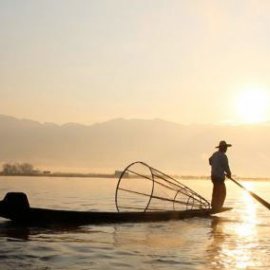The Blue Economy
-
English
-
ListenPause
I’m Peter Neill, Director of the World Ocean Observatory. “The concept of the ‘blue planet’ for many people conjures up a sense of the unknown, the unsettling and the unmanageable. It is the realm of the explorer still, and without a doubt, many important discoveries are yet to be made. Many involve the science of sustainability. Success is critical for many reasons. Above all, we are destroying biological diversity and the habitats of our ‘one ocean’ in ways that make sustainable use of resources and ecological services increasingly difficult wherever we live.” I am quoting from the Forward of a recent report, The State of Sustainability Initiatives Review: Standards and the Blue Economy, published by the International Institute for Sustainable Development, a Canadian think-tank devoted to all aspects of development in the 21st century. It continues, “It is fashionable now to speak of the ‘blue economy.” In the mindset of some, this is primarily an exercise in how to extract more economic value from the oceans. For others, it is a clever twist to seek higher economic and social value while providing a greater ecological security of use. This is much the same as the more generally applied ‘green growth’ and ‘green economy’ concepts. Or so it might seem. Yet it really is not the case. The knowledge gap is far greater for the blue economy, and the necessary instruments are far less developed. It would be nice to believe, for example, that we truly understand the complex interactions within ocean ecosystems necessary for sustainable fisheries management, or that we have achieved sustainable aquaculture. Or that the problems of waste from land-based sources of marine pollution have been solved. But the warning signs signal serious dangers ahead.” The idea behind this project is to provide the research, analysis, and suggested standards that might serve as policy and operational guidelines to governments and those engaged in ocean enterprise to voluntarily adopt as a means to address the short-term crisis and the long-term viability and exploitation of ocean resources. The seafood industry is, of course, a major area of concern as a critical source of food protein and global employment, with an estimated trade value in 2014 at US$140 billion. Some 3 billion people depend on seafood for their livelihood, and estimated pressure on global fish stocks indicates 88% being either fully or over-exploited. Some of the findings are particularly interesting: production of certified seafood, for example, has increased at a rate of 35% per annum, indicating a remarkable market demand by more knowledgeable consumers and the application of standards by fishers seeking brand differentiation in response. Some 80% of this amount is wild catch, but with certified aquaculture growing at twice that annual rate. Five species groups account for more than two-thirds of this supply: anchovy 29%, cod 16%, salmon 15%, tuna 8%, and mackerel 4%, mostly distributed to developed country retail markets. Certified production is concentrated in Peru 25%, US 15%, Norway 11%, Chile 8%, and Russia 6%. Europe and North America account for 63% of the total, with Latin America increasing as an important new source. Asia, which accounts for 69% of total global seafood production, only occupies 11% of the certified production. All this is, of course, complicated by data scarcity, erratic reporting, flawed estimates, and the exclusion of remaining un-assessed stocks. It is clear, however, that certified aquaculture will dominate future growth, with Viet Nam and China expected to increase certified supply dramatically in the coming years. Acceptance of standards is voluntary, and thus problems remain with coverage, traceability and conformity, third-party certification, local adaptations, consistency along the supply chain, conflict of smallholder and regional interests, low level representation of developing country producers, and international restrictions on illegal, unreported and unregulated fishing. These issues are acknowledged, and must be addressed if the certified fisheries are to remain in place, viable over time, and adequate to the growing worldwide demand. The Blue Economy is real, complicated, growing, and still mostly invisible to the public, financial analysts, and many policy-makers around the world. That is changing, and its calculation into the great equation essential if we are to find our way forward sustainably reliant on the many positive functions of the world ocean. We will discuss these issues, and more, in future editions of World Ocean Radio.
In this episode of World Ocean Radio, host Peter Neill discusses a recent report entitled "The State of Sustainability Initiatives Review: Standards and the Blue Economy" and the state of global fisheries. The new IISD report provides research, analysis, and suggested standards that might serve as policy and guidelines to address both the crisis and viability of ocean resources.
About World Ocean Radio
Peter Neill, Director of the World Ocean Observatory and host of World Ocean Radio, provides coverage of a broad spectrum of ocean issues from science and education to advocacy and exemplary projects. World Ocean Radio, a project of the World Ocean Observatory, is a weekly series of five-minute audio essays available for syndicated use at no cost by college and community radio stations worldwide. A selection of episodes is now available in Portuguese, Spanish, French, Swahili, and Mandarin, enabling us to reach 75% of the world's population. For more information, visit WorldOceanObservatory.org/world-ocean-radio-global.
Image Credit
IISD Report: State of Sustainability Initiatives Review
- Login to post comments



